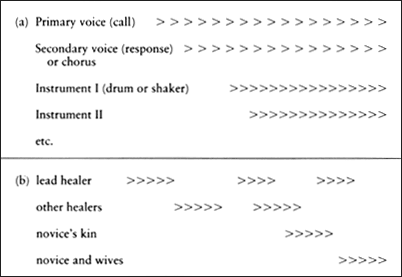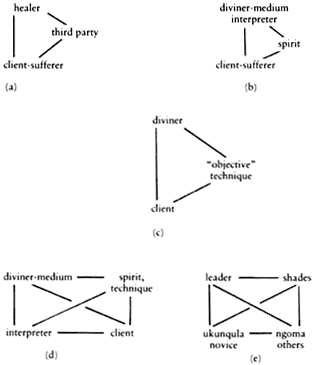The Structure Of Ngoma Therapeutic Communication
One way of comprehending the place of ngoma song in African healing is to take seriously the reference to text, texture, and context, and to look not only at the content of the songs but at the structure of these communications. The underlying and most pervasive structure of ngoma is the call-and-response pattern that is common in most African music. This is true not only of the songs, but of the very structure of the music and the ritual itself. There are numerous variations on this theme: sufferer and healer; sufferers among themselves; healers among themselves; sufferer, healer, and others; elements of sufferer's kin group; and spirits and humans. Since little collected therapeutic song material gives the relational context clearly, we need here to depend on the examples available from across the ngoma region.
The Western Cape example of "doing ngoma" offers a ready illustration of the call-and-response motif of song. The invocation, spoken, is followed by a song that is intoned by the speaker. The surrounding individuals join in with song. There are further amplifications of the call-response rhythm. There is the dialectic of speaking and singing. Within the singing there may be a call-and-response pattern. The sets of invocation (ukunqula ) and song-dance (ngoma) are referred to by the set call "Camugwini ?" and the response "Camagusba! " These two applications of the common verb "to agree," or "to have consensus, or affirm," pave the way for a well-understood routine that brings a sufferer into the group, sets him or her up to offer a few thoughts or concerns, and for the others to respond to them in an affirming, supporting manner. Throughout all of this, instrumental accompaniment is limited to the song-dance, and follows the vocalized, danced portion of the set. This is in keeping, everywhere, with the pattern of instruments becoming a secondary or tertiary voice in the sequence of voices entering in. According to Simha Arom's massive work Polyphonies et polyrythmies instrumentales d'Afrique centrale (1985), this feature is basic to musical styles across Africa. It is the foundation upon which
the unique features of polyrhythmic and polyphonic patterns are built (see fig. 11a).
A more elaborate pattern of different voices is illustrated in the account of Lemba songs offered above. Here, senior priests and priestesses, the novice priest and priestesses, and the patrifilial children of the novice priest exchanged turns leading their songs in a "graduation" rite (Janzen 1982:114–121). These songs are intoned with the verbal call "Ko-ko-ko?" (suggestive of the drums) and the response "Ko!" Then the lead singer opens with a phrase such as "Will you gain Lemba?" and the chorus responds with "Yes—Lemba!" This is followed by the body of the song-dance performance of each particular song, with its recurrent internal call-and-response pattern.
A further, larger structure reflects the parties present in the rite. Throughout the event, the progression of lead singers is the following: (1) sponsoring healer or Lemba Father; (2) the other Lemba priests who are present at the event (sometimes the Lemba priestesses have a separate song); (3) the patrifilial "children" or offspring of the novice (that is, the offspring of males of his matriclan—a classificatory support group); (4) finally, the novice, after he and his wives have completed their initiations (see fig. 11b).
In the communication pattern of song in which divination is done, an even more complex exchange emerges at times. This can come in two ways. The first is in the presence of a third party who affirms or negates the interpretation of the diviner-healer; the second comes in those cases in which the diviner acts as a medium for a spirit. In Southern Africa the "third party," either an assistant to the diviner or a kin or friend representing the client-sufferer, responds to the divinatory interpretation of the diviner. After each utterance of the diviner, the third party intones "I agree" (si ya vuma ) or "I do not agree." In the first case the diviner will continue the course of analysis of the case until reaching a conclusion. In the latter, the diviner will back up and try another track of analysis or will stop to discuss the case with the client. However, in Southern Africa and elsewhere, the diviner is often expected to establish the truth through a variety of convincing means, mechanistic or inspirational. Divination is not an empirical science based on questioning and the study of empirical evidence; it is held to be a mystical art, based on clairvoyant knowledge and wisdom. Thus, at the end of the session, there is agreement.[2]
When this clairvoyance is expressed in mediumistic form with the spirit invading and speaking through the diviner, in a sense the spirit
Figure 11.
(a) The structure and sequence of voices and instrumentation in
ngoma song, common to African music more widely; (b) the relationship
of "roles" or "parts" in a documented ngoma event in North Kongo in the
early twentieth century (Janzen 1982:106–124).
is the third party along with the diviner and the client-sufferer. In the ethos of possession divining, it is not appropriate to disagree with the spirit. One may not understand the spirit, but it is always right. Therefore the diviner becomes the third party, interpreting the utterances of the spirit as they are channeled through him or her, much as the diviner interprets the bones in Southern Africa, or the Ngombo basket objects on the Southern Savanna, or the shells of the Ifa oracle.
The combination of multiple communicative dimensions of vocal, visual, instrumental, and spatial and social domains enriches the overall "text" in ngoma, allowing it to articulate the complexity and contradictions of human experience. This process is enhanced by the addition of interpreters or the addition of points to the communicative structure (fig. 12) and of music to the communication, all of which we may speak of as "ritualization."
In several anthropological definitions of ritual inspired by communications theory (e.g., Leach 1966, 1976; Bateson 1958, 1972) the essence of ritualization is the process of adding channels or mediums of expression to a discourse so that there may be multiple, or redundant,
Figure 12.
Modes of mediation in ngoma communication. These variations
model most of the cases presented in this work in terms of structures
between subjects or "players." Setting (a) shows a common clinical setting
with a therapy manager mediating between healer and sufferer. Divination
usually offers two types of structures, (b) and (c), in which the technique or
the shade/spirit become the message mode between healer and sufferer-
client. A more elaborate model emerges, (d) and (e), in which there is an
interpreter for the diviner and the spirit or technique (as in Nguni divining
where someone intervenes to "agree" or "disagree" on behalf of the client.
This model also applies to "doing ngoma" (e) in which there is a session
leader who mediates between spirits and novices, and a particular novice
at a given moment and the others who respond in ngoma.
levels of communication. Thus, in the example cited above, instrumentation would both repeat, and enhance, the primary level of vocal communication. For Bateson and Leach, ritualization occurs because of a "block" or "static" in primary channels of communication and behavior. Redundancy helps to overcome or bypass these blockages. This is not far from Turner's (1968) approach to ritual, which it is based more on the importance of sign and symbol. In this perspective, ritual is simply the greater degree of "density" in the meaning attached to par-
ticular sign referents. Ritual acts out relationships and meanings so as to heighten emotion and to articulate contradictory sentiments. These authors are not, however, overly concerned with the role of music in ritualization, although their theories do not contradict the focus upon music that is ultimately required to understand Central and Southern African ngoma.

